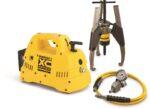EMEX 2018
Behold the Bosch Robot! Transformed from toolbox to 4.8m titan with Bosch power tools. See this NZ Design award-winning marvel at NZ Safety Blackwoods stand 2030, EMEX 2018. How many power tools do you think it took to make?

Behold the Bosch Robot! Transformed from toolbox to 4.8m titan with Bosch power tools. See this NZ Design award-winning marvel at NZ Safety Blackwoods stand 2030, EMEX 2018. How many power tools do you think it took to make?

Great to see SpeedMeets in full swing! The next John Britten or Bill Gallagher in the making right here at EMEX 2018
The BusinessNZ Energy Council welcomes the reopening of a potline at NZ Aluminium Smelters at Tiwai Point. The Line 4 quarter potline at Tiwai Point was closed in 2012 as production there became unprofitable due to low global aluminium prices and high electricity spot prices. Now the potline is to be reinstated as a result of a longer-term fixed-term power agreement with Meridian Energy. BusinessNZ Energy Council Chair David Caygill said the agreement indicated the strength and competitiveness of the energy market in New Zealand. “It shows New Zealand-produced electricity being delivered in a workable competitive market, supporting industry growth. “Reinstatement of the potline will enable increased production by NZAS and more jobs for Southland. “It shows how New Zealand is a great country to establish and expand new manufacturing operations given our high proportion of renewable electricity generation.” Aluminium produced at NZAS produces ten times less carbon than that made in a country with coal dominant generation profile. “The arrangement announced today, underwritten by Meridian and supported by contracts with Contact, Genesis and Mercury, shows that New Zealand is a great place to invest. “New Zealand’s renewable electricity based market provides more confidence for large users than many other countries internationally – a real competitive advantage for this country on the world stage,” Mr Caygill said.

A realigned version of the priority transport projects for Auckland to meet the city’s broader needs is to be commended, says the EMA. The Auckland Transport Alignment Project 2018 announcement confirms the projects the Government and Auckland Council will prioritise in the next decade, along with $28 billion funding required for these. “Auckland’s a growing city and it needs a transport network which supports this. We know congestion is stifling the city’s economy and productivity. Which is why we encourage the Government and council to keep the pressure on to streamline these projects and ensure they happen at pace,” says Kim Campbell, CEO, EMA. “We are heartened that using models such as public private partnerships will be used for some of the projects outlined today. “And there will be value capture benefits that will flow from this programme of work too. “While this announcement was silent on the use of congestion charging, it has made provisions for building more capability in public transport, light rail, which are necessary for a demand management system in the future. “We are pleased to see projects such as the East West link have been retained, if at a significantly reduced funding level. “However, one of our key questions for Government is how proposed changes to employment law will impact this programme of work? Projects such as these rely on the ability to have a flexible workforce, often using a vast number of contracted workers, yet there are legislative changes afoot which we believe will make this process problematic,” says Mr Campbell.

The announcement by the Government that the Crown and the Council have reached agreement to conduct detailed design work on a Stadium for Christchurch is fantastic news for the Canterbury region, says Leeann Watson, Chief Executive of the Canterbury Employers’ Chamber of Commerce. “The commitment to a large capacity enclosed arena is very welcome news. This facility is an important piece of infrastructure that will help bring major events such as concerts, trade shows and major sports matches back to Christchurch.” The guarantee of a venue for these visitor-generating events means business can now plan with certainty their future investments, said Ms Watson. “The lack of clarity about the future of a stadium facility has been difficult for the visitor and hospitality sector. Hopefully this will mean we will see confidence increase and investment decisions being made.” The Chamber will now be focusing on making sure the timeline for the Stadium is brought forward in the Council’s LTP process. “We advocated for a Multi-Use Arena in our written submission. We are also keen to understand the funding plans for the stadium and look forward to further announcements in the near future.” The announcement that the design of the Metro Sports Facility is ready to go to market for costing is also very pleasing said Leeann Watson. “This is an important facility, for both community sports and for recreation users around the city. For instance, we have not had access to an indoor 50m pool in the city since the earthquakes. Swimmers have had to travel to train in full size indoor pools.” The Chamber has welcomed the way costs have been reduced on the project. “Using a more functional approach to design and focusing less on the architectural merits of the structure for a practical community facility is most […]

A time and labour-saving range of Enerpac Sync Grip Pullers that enable one person to safely handle many jobs previously requiring two will be highlighted at the EMEX 2018 engineering machinery exhibition in Auckland from May 1-3. The SG puller range – in mechanical and hydraulic capacities up to 45 tons – will be a highlight of the joint Jonel Hydraulics-Enerpac stand 232 at EMEX, which will simultaneously feature Enerpac’s go-anywhere XC cordless pumps, offering the performance capabilities of an electric or pneumatic powered pump with the convenient portability of a hand pump. XC cordless pumps are constructed of lightweight materials, equipped with a powerful, one-half horsepower motor, and feature 28-volt, Lithium-Ion battery technology. Used with Enerpac’s global range of lifting, forming, crimping, cutting, fabrication and maintenance tools – including hydraulic SG pullers – they promote operator safety by removing trip hazards associated with traditional powered pumps. SG pullers – which feature synchronised movement of their locking jaws for simultaneous engagement and optimised safety – can be used as a standalone tool or hydraulic units can be combined with the cordless pump to deliver outstanding safety and convenience, particularly in hard-to-access areas. “The XC/SG combination is ideal for a wide variety of common maintenance tasks either off-site or in workshops where operations staff appreciate the power and precision of safety-first hydraulics that are easy and convenient to apply to sometimes less accessible and potentially hazardous jobs,” says Enerpac New Zealand Country Manager Mr Neville Stuart. SG-Series Sync Grip Pullers optimise safety, simplicity and speed of removal of bearings, bushings, gears, sleeves, wheels, fly-wheels, sprockets and other shaft-mounted items. They enable one person to do jobs that often previously took two, in applications such as maintenance of fixed and mobile machinery and plant as well as heavy vehicles and rolling […]

New Zealand plastics manufacturers have long held a world-wide reputation for innovation, and the uptake of the latest technologies. It is for this reason that many of our companies continue to excel on the world stage. Tasman Machinery is proud to supply many of these world leading organisations. At EMEX 2018 Tasman Machinery (Stand 3005) will be running a live display of a Sumitomo (SHI) Demag all electric injection moulding machine, in combination with a Yushin 3 axis servo driven robot.NZM MEDIA KIT 2018 Features of the Sumitomo (SHI) Demag machine include the latest direct drive servo technology, to ensure the ultimate in accuracy, repeatability, energy efficiency, and durability. Sumitomo’s patented direct drive technology sets it apart from all its competitors and has ensured that Sumitomo (SHI) Demag is the No.1 selling all electric injection moulding machine across the globe, including here in NZ. Included in the display will be the latest robot takeout technology from Yushin. The YCII Series from Yushin combines many interesting features, including carbon fibre reinforced axis, design optimisation for weight reduction, and energy efficiency designs, to ensure the lowest running costs.

EMEX 2018 can’t be missed, as over 170 international and local exhibitors will inform, delight, entertain and celebrate kiwi design and innovation across the 3 days. There’s also the serious business of putting forward great commercial deals for the manufacturing community. If you’re in Engineering, Manufacturing or Electronics then you really need to visit this free event to best position your business with the latest technology on offer. DISCOVER – what not to miss! World leading automated and robotic plasma cutting systems, designed and build right here in New Zealand for local and international markets by Plazmax in Rotorua, is highlighting the Kiwi Made Innovation feature at EMEX 2018 showcasing 3 separate automated plasma cutting systems, bringing both new and improved innovation to the market. Plazmax will be showcasing their world class capabilities with live demonstrations for all interested parties. After their introduction at SouthMACH 2017, Caliber Design and Locus Research are back at EMEX 2018 and proud to present some amazing examples of collaborative product design in the newly created Innovation Quarter. The products on display at EMEX 2018; the Stabicraft 1600 Fisher, the Ubco 4 x 4 bike and the 2018 Oscar winning Shotover Camera System, are the result of an intensive interaction during the entire product development process. You’ll be impressed by what you’ll see! ENGAGE – Find the right people for the job The Employment and Training Hub will provide you with the opportunity to discuss the well documented skills shortages in the industry with experts from M.I.T and Competenz. As a manufacturer or engineering company this is your chance to learn more about these highly successful programs. You’ll have your chance to engage potential apprentices who have chosen a career in technology by signing up for the ’speed meets’ that are organised during EMEX 2018. […]

Protecting welders against welding fumes is an ongoing topic of discussion. This is partly because of the importance to maintain welder safety, and partly because of the common law and statutory obligations of employers to do so. The subject is again in the spotlight following the release of findings by the International Agency for Research on Cancer (IARC), which re-classified welding fumes as “carcinogenic to humans”. (See the reference abstract at The Lancet Oncology) http://www.thelancet.com/journals/lanonc/article/PIIS1470-2045(17)30255-3/abstract For employers, the reclassification of welding fumes as “carcinogenic to humans” will spur many to consider changing the type of welding helmets issued to their staff or supplied by sub contractors working in a welding environment on their behalf. Traditional basic welding helmets do provide protection against different intensities of light from arc flash using appropriate shading in welding lenses. They also protect against airborne metallic debris from the grinding process by using a suitable grinding visor, as well as afford the welder physical protection against external hazard. However, the IARC findings will now likely further fuel the need for the use of helmets that also minimise the risks associated with inhaling welding fumes. When assessing such helmets, employers and welders should consider integrated respirator systems that supply positive pressure airflow to reduce heat discomfort experienced from continuous welding. The system should also include filtration that removes particulate, fume and odour. Additionally, the system would include a gas scrubber/filter to remove potentially harmful elements in vapour phase associated directly with the welding activity. These safety features, when combined with a helmet that maximises the viewing area and clarity, offers simple helmet adjustment control or change to a grinding visor function without the need to remove the helmet, will likely help to ensure the welding activity is achieved without forgoing quality and productivity. At EMEX 2018, […]

Two leading academics have developed a new food design technique to help inspire the next generation of culinary designers and make artistic food presentation more accessible to New Zealand restaurants. The new technique developed in consultation with EPIC Otago Polytechnic R & D centre and The Food Design Institute at Otago Polytechnic allows chefs to produce large quantities of artistically designed food products by hand on a commercial scale with a small team, and at reduced cost. Otago Polytechnic’s Timothy Lynch, who and lectures on sustainability in the food industry, says they wanted to present ingredients in a way that was consistent with multisensory food design concepts. “The process involves working with natural products to design handcrafted foods that look identical to fruit and vegetables but are filled with contrasting flavours.” “Initially we couldn’t find a way to make these products on a small scale, but a collaboration with the EPIC helped us overcome several barriers, and we were able to develop a method of crafting the lifelike products using food-grade silicon moulds, which we made ourselves,” he says. Lynch says a project of this scale and complexity would require international assistance and a large team of scientists and food specialists. This would have made the project cost prohibitive by New Zealand industry standards, he says. “Thanks to the ingenuity of some of our colleagues and the dedication of our staff and students we have managed to find a way to bring these food creations to life,”- says Lynch. Senior lecturer Tony Heptinstall who has catered for Prince Charles and other royal family members says one of the objectives was to increase current industry capital through being part of an innovative collaboration between the food industry and education. “We were conscious that to inspire the students we needed to take on […]